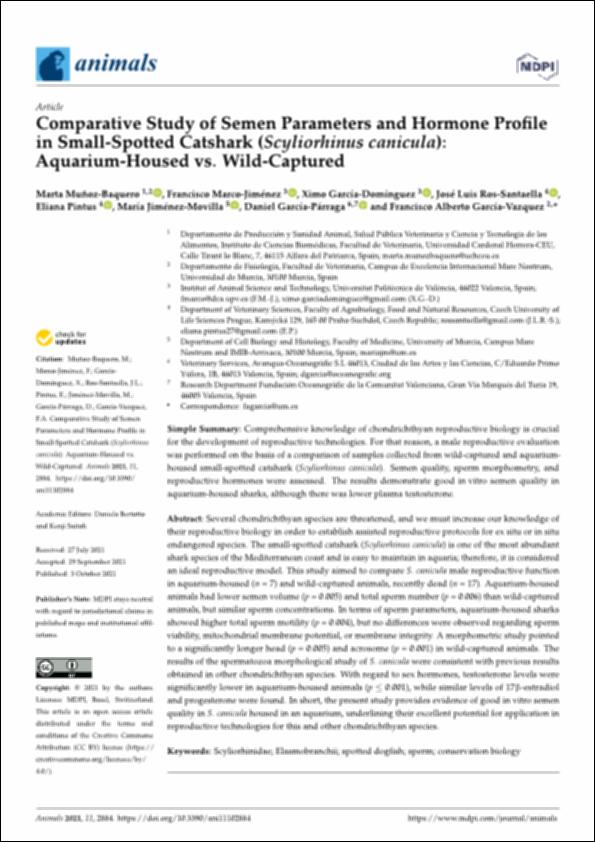Por favor, use este identificador para citar o enlazar este ítem:
http://hdl.handle.net/10637/13545Comparative study of semen parameters and hormone profile in Small-Spotted Catshark (Scyliorhinus canicula) : aquarium-housed vs. wild-captured
| Título : | Comparative study of semen parameters and hormone profile in Small-Spotted Catshark (Scyliorhinus canicula) : aquarium-housed vs. wild-captured |
| Autor : | Muñoz Baquero, Marta Marco Jiménez, Francisco García Domínguez, Ximo Ros Santaella, José Luis Pintus, Eliana Jiménez Movilla, María García Párraga, Daniel García Vázquez, Francisco Alberto |
| Materias: | Tiburones - Reproducción.; Sharks - Reproduction.; Spermatozoa - Quality control.; Scyliorhinus canicula - Protección.; Scyliorhinus canicula - Protection.; Esperma - Control de calidad. |
| Editorial : | MDPI |
| Citación : | Muñoz-Baquero, M., Marco-Jiménez, F., García-Domínguez, X., Ros-Santaella, J. L., Pintus, E., Jiménez-Movilla, M., García-Párraga, D. & García-Vazquez, F. A. (2021). Comparative study of semen parameters and hormone profile in small-spotted catshark (Scyliorhinus canicula): aquarium-housed vs. wild-captured. Animals, vol. 11, i. 10 (03 oct.), art. 2884. DOI: https://doi.org/10.3390/ani11102884 |
| Resumen : | Several chondrichthyan species are threatened, and we must increase our knowledge of their reproductive biology in order to establish assisted reproductive protocols for ex situ or in situ endangered species. The small-spotted catshark (Scyliorhinus canicula) is one of the most abundant shark species of the Mediterranean coast and is easy to maintain in aquaria; therefore, it is considered an ideal reproductive model. This study aimed to compare S. canicula male reproductive function in aquarium-housed (n = 7) and wild-captured animals, recently dead (n = 17). Aquarium-housed animals had lower semen volume (p = 0.005) and total sperm number (p = 0.006) than wild-captured animals, but similar sperm concentrations. In terms of sperm parameters, aquarium-housed sharks showed higher total sperm motility (p = 0.004), but no differences were observed regarding sperm viability, mitochondrial membrane potential, or membrane integrity. A morphometric study pointed to a significantly longer head (p = 0.005) and acrosome (p = 0.001) in wild-captured animals. The results of the spermatozoa morphological study of S. canicula were consistent with previous results obtained in other chondrichthyan species. With regard to sex hormones, testosterone levels were significantly lower in aquarium-housed animals (p 0.001), while similar levels of 17 -estradiol and progesterone were found. In short, the present study provides evidence of good in vitro semen quality in S. canicula housed in an aquarium, underlining their excellent potential for application in reproductive technologies for this and other chondrichthyan species. |
| Descripción : | Este artículo se encuentra disponible en la siguiente URL: https://www.mdpi.com/2076-2615/11/10/2884 Este artículo pertenece a la sección "Aquatic Animals". |
| URI : | http://hdl.handle.net/10637/13545 |
| Derechos: | http://creativecommons.org/licenses/by/4.0/deed.es |
| ISSN : | 2076-2615 (Electrónico) |
| Fecha de publicación : | 3-oct-2021 |
| Centro : | Universidad Cardenal Herrera-CEU |
| Aparece en las colecciones: | Dpto. Producción y Sanidad Animal, Salud Pública Veterinaria y Ciencia y Tecnología de los Alimentos |
Los ítems de DSpace están protegidos por copyright, con todos los derechos reservados, a menos que se indique lo contrario.


